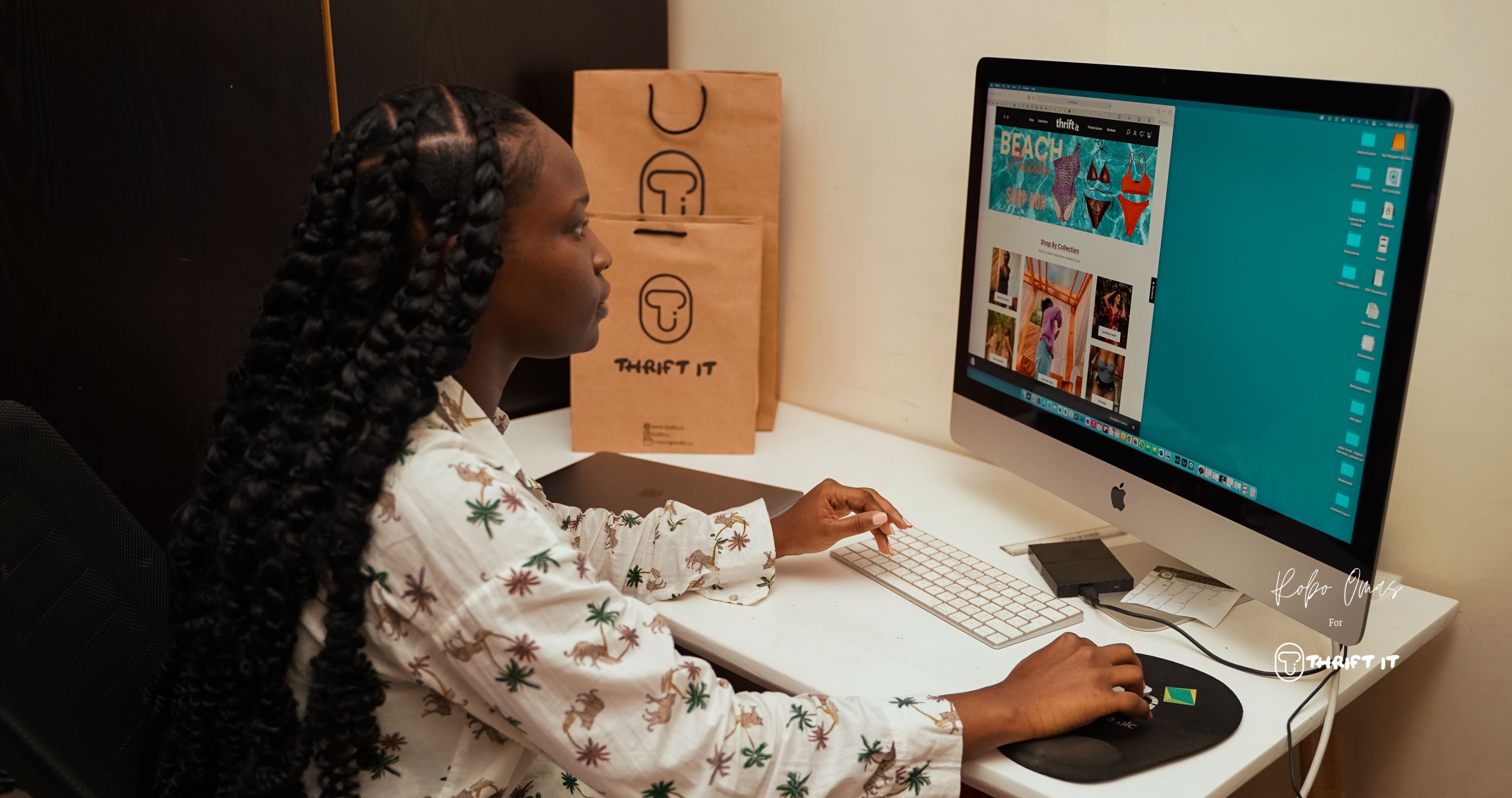Nigeria’s border laws and customs policies make it possible for tonnes of secondhand clothing to be imported into the country every year. The women entrepreneurs in this story saw a need to rebrand the way these items are bought across the country and, with their technology-powered businesses, are making thrifting easy, accessible and cool.
Tejuosho Market, Yaba, Lagos, is one of the bustling city’s many nerve centres. The market, located on the mainland of Nigeria’s economic capital and comprising two ultra-modern shopping complexes is a tireless flurry of activity overflowing in and around the vicinity. Each day, particularly in the evenings, much of this commotion comes from secondhand clothing traders and their customers, mostly young women bending, picking and inspecting clothing items from large heaps. The bales of secondhand clothes—denim pants, dresses, tops, jackets, overalls, scarves, with their characteristic secondhand odour and wrinkling—come from a variety of places in the west often berthing in Nigeria through ports in neighbouring West African cities like Lomé and Cotonou. On the specific market days when these bundles of clothing are “opened” at Tejuosho, the human traffic and stress of sorting through them with tens of others, equally looking for that special bargain can be daunting. Not many women can, or want to withstand this and other challenges of open-market shopping in Lagos.
Onyeka and Ifeoma Nwobu launched their thrift business, Frugirls, to take out this stressful middle for women. Although they had informally trialled the business, the social commerce store officially started trading in December 2019 on Instagram. Onyeka Nwobu says part of the initial interest in thrifting comes from being raised by a frugal mother who shopped for their clothing items in open flea markets and had an eye for excellent pieces. They were often asked by friends where they got their clothes. “There’s all sorts of thrift, all grades of thrift. We specialise in affordable premium wear for women in Nigeria,” she tells AMAKA.
While Robo Omavuohrerhe did not appreciate the stress of shopping for thrift clothing at open flea markets, an emergency prolonged stay in Nigeria, after she returned from the UK, necessitated a new wardrobe. And secondhand clothes proved to be a more financially reasonable alternative. “I was coming from a place where I could get a top for £5 or £10 and that wasn’t too much for me,” Omavuohrerhe recalls. “Then I came here and I was seeing ₦15,000 (£25) for one dress and I needed to get a whole wardrobe that was going to sustain the length of time I was spending in Nigeria.” Like the Nwobu sisters, Omavuohrerhe tested her idea informally as she bought and sold clothing items she liked but whose sizes did not match. Thrift It, launched earlier this year on Instagram and with an e-commerce store. “Thrift It is like ASOS but for second-hand clothing in Nigeria,” she says.
Fast Fashion Rip Offs: Building Resilience as an Independent Brand

Shop or pass?
Attitudes towards secondhand clothing in Nigeria differ. Though some of the growing social media thrift businesses have made efforts to reposition the narrative around thrifting, many are still not keen to patronise them. For starters, the terms “okrika” and “bend-down-select,” local terms for secondhand clothing, can carry negative connotations. While the former refers to a port town in southern Nigeria where all secondhand clothes were once said to arrive; the latter refers to how these clothes are shopped for at open markets across the country—scavenging through a heap of castoffs for the least worn clothing items.
Thrifting can also carry negative connotations. Organisations like the National Association of Resale and Thrift Shops in the US, equate thrift shops to those run by not-for-profit organisations where mostly donated, but also consigned inventory, are sold at giveaway prices. While most secondhand clothing vendors in Nigeria refer to themselves as “thrift,” the terms “resale” or “consignment” seem more accurate. Consequently, terminology does play a role in how potential customers in this part of the world perceive the industry.
Onyeka Nwobu says nomenclature can be misleading. “Thrift is not charity. It’s the business that powers charity,” she says. “We just need to be able to make these things clear to people.” According to her, it has been surprising to find “more elite-thinking people shopping thrift.” For these customers, she says, thrifting stems from a more environmentally conscious place more than anything else.
At Thrift It, where Omavuohrerhe combines social and online commerce, and stocks a few brand new clothing items as well, it is not unusual to find customers who have items in their carts abandon the purchase once they hear those items are secondhand. “For me it’s not a big deal but I understand why it’ll be a big deal for some people,” she says. “They’ve been trained to think that secondhand items are for less privileged people.”
Jane Nnoli’s (Not her real name) mother, like the Nwobu sisters, used to buy her clothes from open flea markets because it was more economical when she was younger. She tells AMAKA it made her feel “poor” and “less privileged.” Today, Nnoli is a brand marketing strategist based in Lagos. “I decided to do better as soon as I started earning,” she explains. “It’s the reason why I would prefer to buy a new piece of clothing than a thrifted item no matter how cheap.”
Omon Okhuevbie, a journalist who founded 300ThriftStore three years ago, has first-hand insight about the perception of some customers towards thrifting because of their reluctance to have their images shared on her page wearing items purchased from her store. They don’t want to be openly seen as having bought thrift items or at her ridiculously low prices.

Old wine, new wine skins
Customers who patronise businesses like Frugirls and Thrift It are leaning into a blossoming online commerce industry looking to change how thrift is presented and shopped. Search through Instagram, Facebook or Twitter and you will find myriads of them thrifting everything from clothes and shoes to perfumes and furniture. These businesses are taking away the irritation of shopping at open flea markets as well as presenting clothing items in clean, sweet-smelling glamorous ways.
At Frugirls for instance, clothing items are laundered to remove the off-putting characteristic secondhand smell, steamed and sometimes mended if a button is missing or an elastic band has slackened. This is factored into the cost of the items eventually. Both sisters, one of whom has a career as a model, sample the pieces themselves in the eye-catching and modern content that they create for the brand.
Thrift It, with its ASOS-like website, photographs each item on a simple outlay and has optimised its offerings so that buyers can shop by sizes or prices or in collections just as they would on ASOS or Zara.
Okhuevbie, who says shopping at open flea markets feels more like a treasure hunt, sometimes alters the designs to look and feel different when stocking for 300ThriftStore, a practice inspired by popular American resale brand, Random&Chic.


The ebbs and flows of online commerce in Nigeria
Since 2014, online shoppers in Africa have increased by 14 percent annually compared to a 12 percent global average. In the past year, the impact of the global pandemic has been pivotal in winning more converts, as more people practiced retail therapy online due to lockdowns and global restricted movements. However, in spite of this commendable trajectory, infrastructure challenges like logistics, payments and internet access continue to hamper how revolutionary e-commerce was expected to be on the continent. “Nigerians are not very trusting of online commerce,” says Ifeoma Nwobu. With online payments, for instance, cyber fraud still serves as a deterrent to a variety of payment options and Frugirls relies on a good old bank transfer when customers make a purchase. Logistics-wise, shipping costs can be exorbitant for inter-city deliveries, limiting the reach of the online orders they get in spite of the borderless nature of an online commerce store. Omavuohrerhe says what has been more of a challenge for Thrift It, is that a small percentage of shoppers are still unable to make purchases through the e-commerce website. “I get a lot of people who’ll literally go on the website, take screenshots and then come into the DM and say, I want to order these.”
Social commerce, a merger between e-commerce and social interaction thrives on these sorts of exchange. According to Instagram’s internal data from October 2019, 90 percent of Instagram users follow at least one business on the platform. In emerging countries, social commerce not only serves small and medium scale businesses; it also helps to reach individuals and potential buyers who are still uncomfortable with the somewhat abstract notion of shopping on a web platform with little to no human interaction. On the continent, there are very few native social commerce platforms, unlike in countries such as China. Nevertheless, social media and messaging apps like Instagram, Facebook and WhatsApp with their storefront and business features are offering SMEs the ability to merge marketing, sales support and branding capabilities, with connecting and building a community around their businesses.
This ability to directly interact with customers means that their desires, complaints and preferences can be captured with very little marketing budget or complexity. And brands can develop services that are well tailored to suit their target audience. Take Frugirl’s bid and buy initiative for example, Ifeoma Nwobu says the idea came about as a result of ongoing discussions that online thrift businesses were being exploitative with their pricing. “So, we wanted to get into the mind of our community by finding out what they would pay for our stock if we did not put price tags,” she says. Using Instagram’s Poll feature, the sisters sampled different clothing items and gave their buyers a chance to decide their preferred price points from a base point that ensured they made a profit. Like haggling at an open flea market, items go to the customers who arrive at a good bargain fastest.
More broadly, with a great customer experience, brands can quickly gain social capital and positive brand equity as customers share their experience with their own social circles on these platforms. On the flip side, it is also very easy to lose brand equity when customers repeatedly have complaints about a product or service.
The big picture
Globally, thrifting apps are part of a blooming technology industry, attracting millions of dollars of venture capital and reaching for the pinnacle of domination in their tech niches. Early this year, Curtsy, an American women’s clothing resale app, raised $11 million in a Series A funding round. Launched in 2016, as a peer-to-peer cloth rental platform, the company allows for a circular trade where women list clothing items they want to sell. At an average monthly growth of around 30 percent, the company takes a 20 percent commission on each sale.
Vinted, the European secondhand marketplace which was valued at $1 billion in 2019, raised $303 million in May this year and is now valued at $4.5 billion. Like Curtsy, the marketplace allows users to list clothing (and home) items for resale and purchase by its 45 million users.
Onyeka Nwobu says she is thinking about scaling and what that looks like for a thrift business. Vinted and Curtsy perhaps provide templates of what is possible. For the foreseeable future, changing perceptions around thrifting still has a long way to go before it can become positive and strong enough to attract the millions of sellers and buyers both platforms command. But the market exists and things are beginning to shift.
At Thrift It, Omavuohrerhe is keen on growing the range of services she offers and is looking to introduce a resale option soon. “We are introducing something in a few weeks where people can actually send in their clothes,” she says. “Because it’s always buy, buy, buy but what happens to what you already have?”
Okhuevbie, founder of 300ThriftStore tells AMAKA, she is also considering an offline-online dynamic particularly considering recent disposition of the government towards social media. On June 4, the Nigerian government announced a Twitter ban which is yet to be lifted. “If I had a large customer base on Twitter, imagine what would’ve happened,” says Okhuevbie whose store presence spans Instagram, Facebook and Twitter. Partial or full internet shutdowns and social media restrictions are common on the continent, and in spite of their economic implications, remain weaponized by governments who want to restrict social freedoms and political criticisms.
For now, women who thrift are snagging fashionable pieces at reasonable costs, sometimes with the commitment to doing one's part in the conversations around lifestyle changes to preserve our climate.
